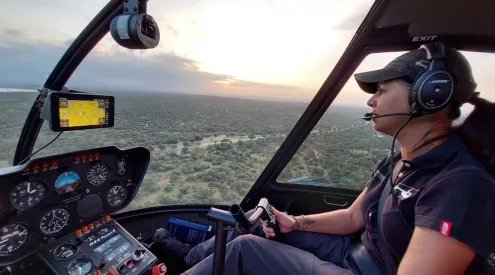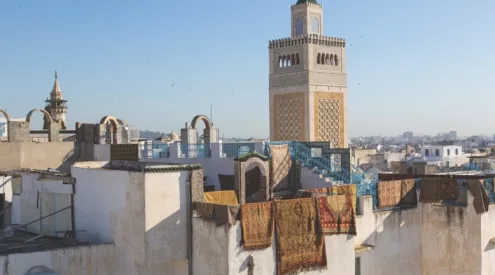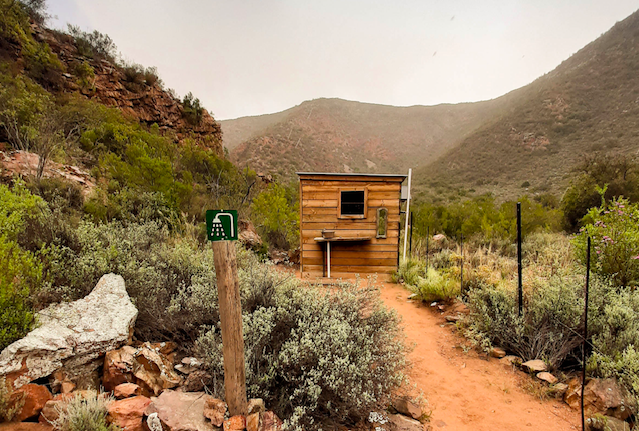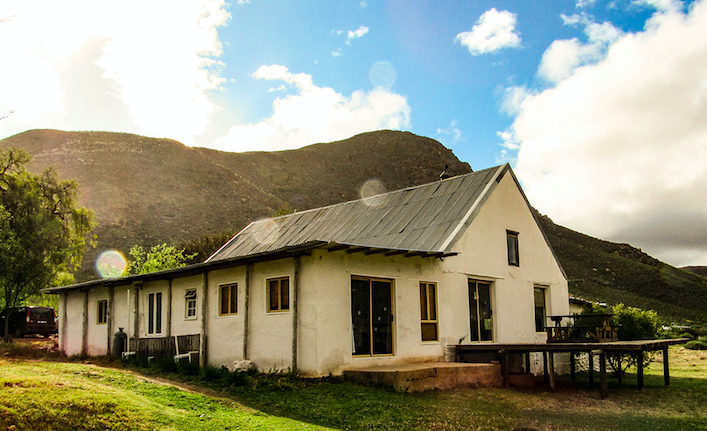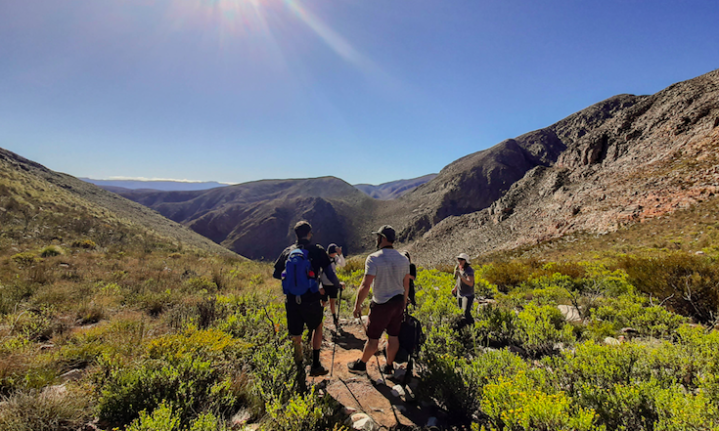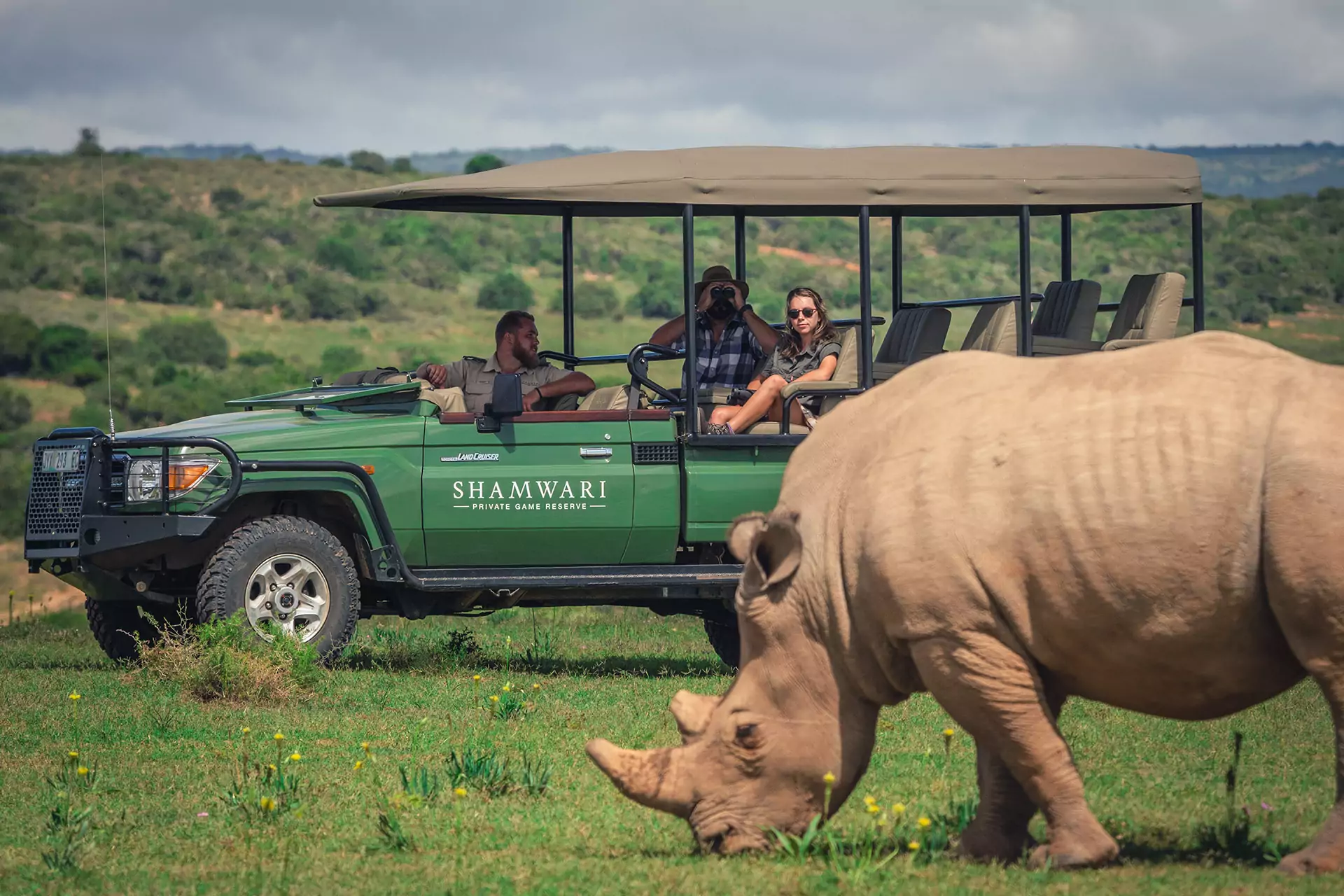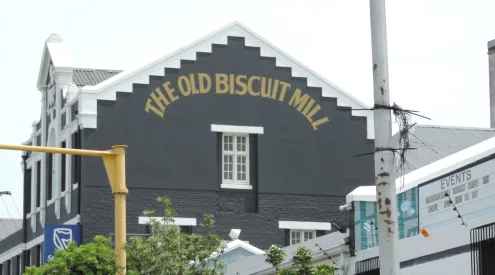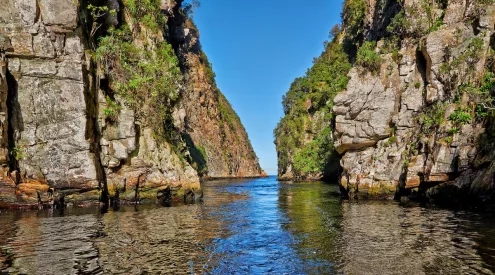It’s well-known that walking allows the mind to wander. Who knew there would be a time when walking felt like a luxury. During those interminable, forgettable lockdown days in June, it was common practice to wish we were somewhere else, in a wide open space where we could walk and walk. Mountains, valleys, views. No cellphone reception. And best of all, no masks! Someone suggested the Bavaiaanskloof Leopard Trail, and before we knew it we had booked with Go Baviaans for their first available date in October. I couldn’t wait to start walking. Without a destination, without a purpose, one step after another.
Our group of 8 arrived at Base Camp on Cedar Falls farm the day before the start of the hike. Red Cliffs Farmhouse, owned by the Booth family, is a roomy building which comfortably sleeps 12. Willem Maganie, manager of the Leopard Trail reception, who has lived on the farm all his life, explained that each hiker receives one big plastic box for the food, bedding and clothes needed for the 4 day hike. The boxes would be transported from camp to camp, while we carried only day packs.
DAY1: 9km – the shortest distance
Spirits were high on the first morning, despite a heavy downpour, one of the first rains after a very long drought. We set off as soon as the storm had calmed to a gentle drizzle. A laboured climb up Kickstart Hill brought us panting to a renosterbos plateau flanked by dolerite koppies. The sun shone briefly through the clouds, and we settled into an even pace.
With a cooling wind and even trail we made easy headway. We took the detour to Gabriel’s Pool – a welcome swimming spot in the hot, rainy season. After the drought, however, the water was a soupy puddle. We enjoyed coffee and rusks while contemplating a wall of overhanging rock. We could make out a San rock painting made of what looked like hundreds of small finger dots. The area is peppered with caves, many of which were once used by the San people until as recently as 150 years ago.
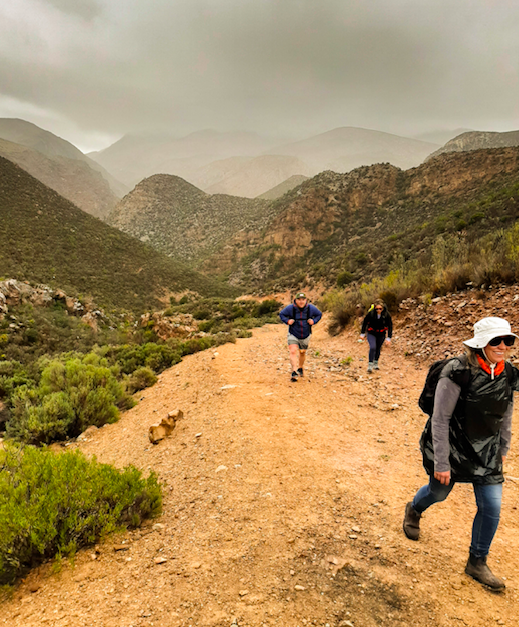
Kickstart Hill
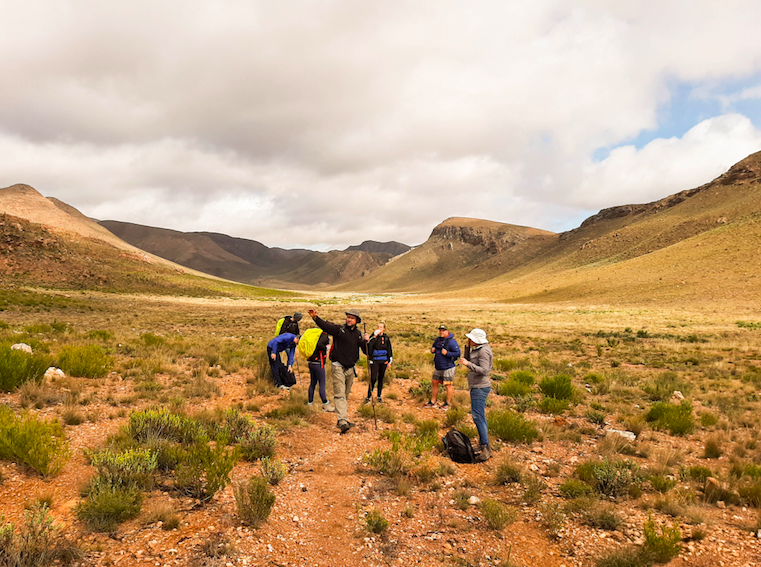
The Leopard Trail was set up in 2014 in the Baviaanskloof World Heritage Wilderness Reserve by Jeanne and Linden Booth’s community development program, Another Way Trust, in conjunction with the Eastern Cape Parks Board.

Consulting the map for our next snack break.

Gabriel’s Pool
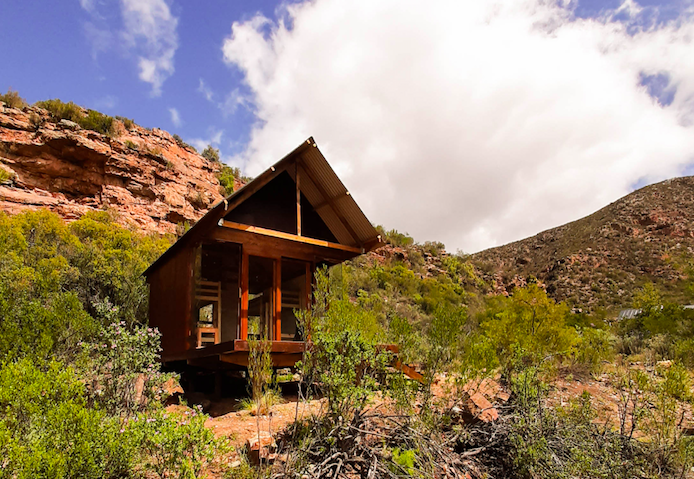
The new huts are designed to maximise the view of surrounding mountains and the starry night sky.
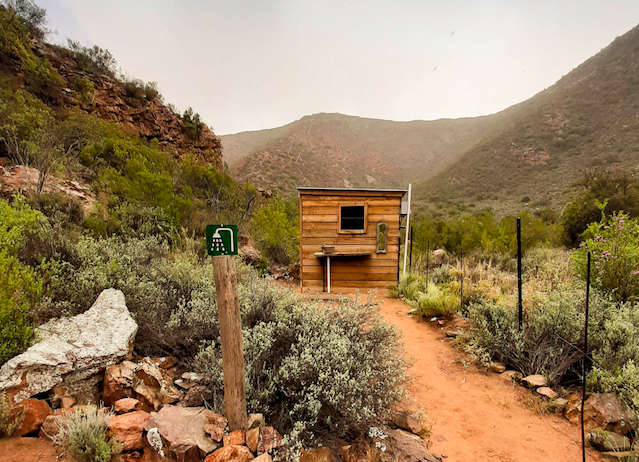
A flush toilet and a very welcome outdoor shower (cold water only), with accompanying bird song.
Day 2: 18km
The second day dawned chilly but dry. We prepared quickly, already well-versed in a routine of packing boxes and daypacks. As we walked out of the valley through a rocky kloof, the sun was warming the day. I imagined we were following an ancient nomadic path, my footsteps covering those of San people from centuries ago. The kloof opened out into the grassy plains of Rhebok Valley, and before long it was time for a coffee break. We decided on a small detour to Cedars viewpoint. “See da view?” was repeated at any opportunity from then on.
A few surviving Cedar trees clung to the tops of the rocky walls rising on each side of the gorge. A wildfire in 2016 destroyed most of the old trees in the Baviaanskloof area, and while the fynbos and smaller scrub have grown back, the larger tree population hasn’t yet recovered.
We gained elevation quickly with a short, sharp climb to the top of the saddle, where the rock-flecked vista of the Kouga and Baviaans foothills opened up before us. The path is well-maintained and frequently sign-posted with the familiar yellow leopard paw icon. Where a fork or crosspaths appeared, we usually spotted an arrow drawn in the sandy ground, so we needed to consult our maps only to agree on the next snack spot. We decided on Reflection Pools, where the rock walls provided cool shade and rang with bird song.
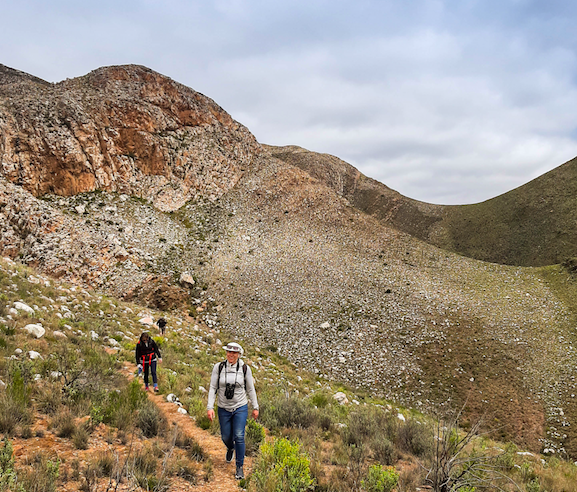
The climb to the top of the saddle.

Overnight site – the huts will be ready for use by December 2020.

As the site is only 500m from Base Camp, we spent the night at Redhills Farmhouse where a hot shower was very welcome!
Day 3: 22km – Longest hike
A sunrise start is advised as the third day is the longest and most strenuous. We spotted a paradise flycatcher among the reeds near Base Camp, and a rock kestrel soaring on a thermal high above us. Two baboons barked vociferously from a nearby peak as we walked along the valley dotted brightly with pink vygies. We tackled the first of the three saddles, the slow incline of Honeybush Hill, before our first coffee stop. The second saddle, Inconvenient Truth, was a steeper, shorter climb, which I preferred to the slow burn of the third incline, Ain’t so Bad. “So… so…. bad” someone puffed, as we reached the top, an elevation of almost 1 200m.
The day warmed quickly, and by 10am it was time for another rest stop. Deep shade at Draaipunt offered a comfortably cool lunch spot, but the highlight of the day was Kasey Kloof. Even in this unusually dry season, the kloof had a lush canopy of leaves and one or two swimmable pools. 262 bird species have been recorded in the greater Kouga-Baviaanskloof Complex, and in this haven we spotted cape sugarbird, cape bulbul, ground woodpecker, lanner falcon, and the faithful Bokmakierie. Remnants of a cape clawless otter’s numerous crab meals, dry leopard scat, and frequent piles of fresh kudu dung indicated we weren’t the only ones to enjoy this small paradise.
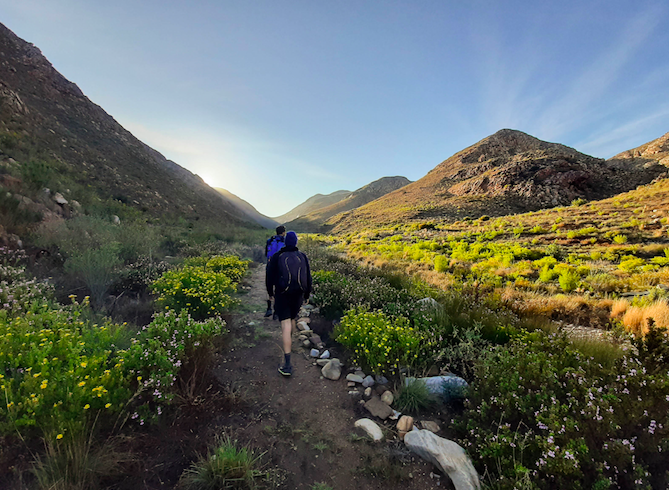
Sunrise start

At the top of Inconvenient Truth
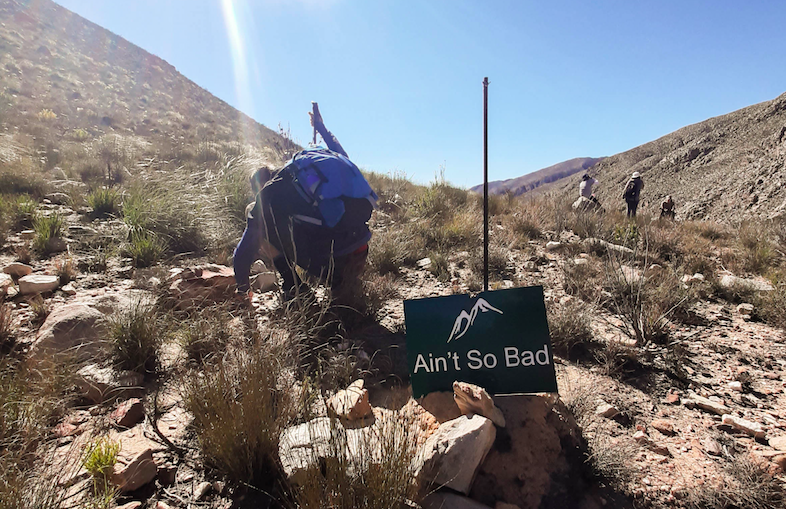
So so bad
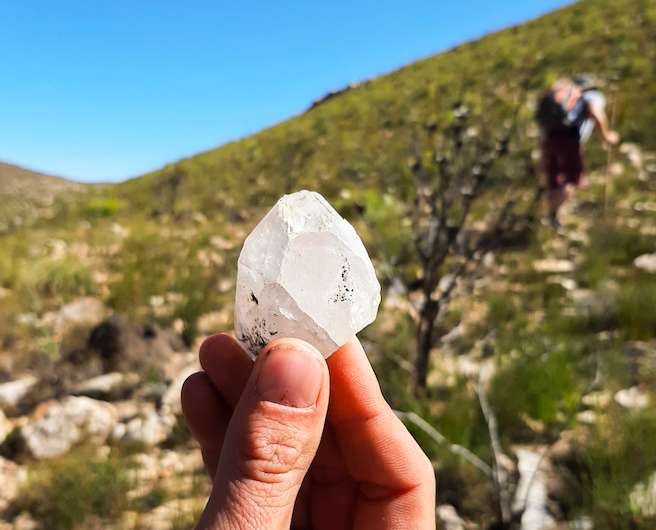
A crystal found in a seam of quartz along the path
Day 4: 13km
There was a tacit agreement among our group to take the last day more slowly. We fell into a companionable silence as we ambled through Birdsong Valley, pausing to munch a few spekboom leaves and admire the many pelargonium species with their delicate flowers along the path.
We stopped frequently to catch our breath, grateful for the cold wind as it whistled among the boulders on the long, arduous climb up Fond Farewell. It was with a sense of accomplishment that we reached the plateau and sat down to take in the majesty of the Baviaans mountains, unfolding endlessly on all sides.
The sky had never felt so big, nor the clouds so white. Here was the feeling of freedom I’d been craving. I stood up and took the next step. And then the next after.
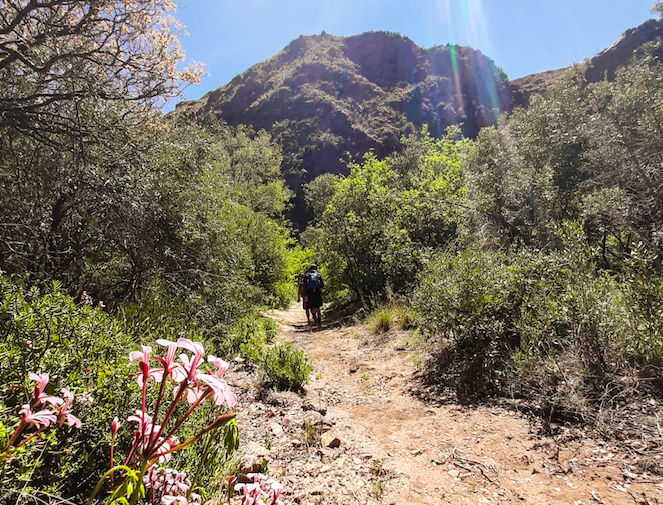
Pelargoniums in Kasey Kloof
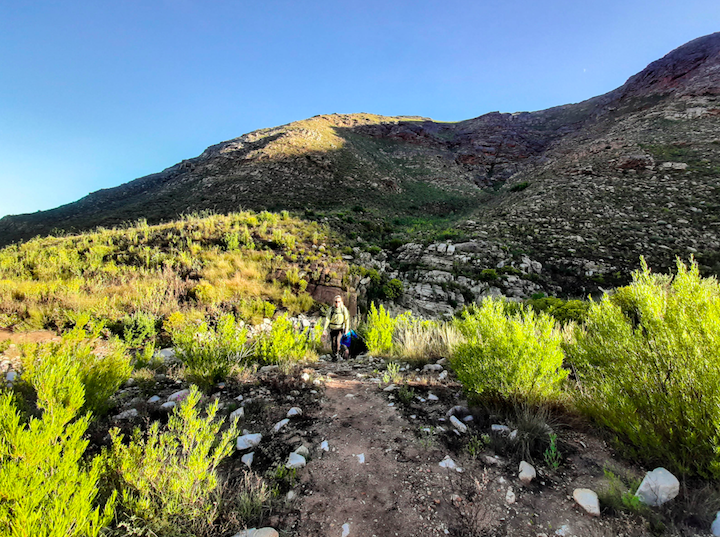
The trails are pristinely clear of human waste, and we didn’t see any other hikers for the majority of our 4 day hike.
Fitness factor: The Leopard Trail is a moderately difficult hike, designed for people with a good hiking fitness.
Tip: Book an extra day to do the Cedar Falls hike, a 4 – 6 hour round trip from Cedar Falls Base Camp, not to be missed. Advance booking is essential as permits for the trail are limited to 12 people per day
The Leopard Trail Cedar Falls Farm: The start of the Leopard Trail – Cedar Falls Farm in the Baviaanskloof World Heritage Wilderness Reserve
The Leopard Trail Cedar Redhill Farmhouse is at Base Camp
Booking: Maximum group of 12, minimum 4.
Contact Catherine: 074 939 4395. Gobaviaans.co.za
Pictures and words: Louise Topping







